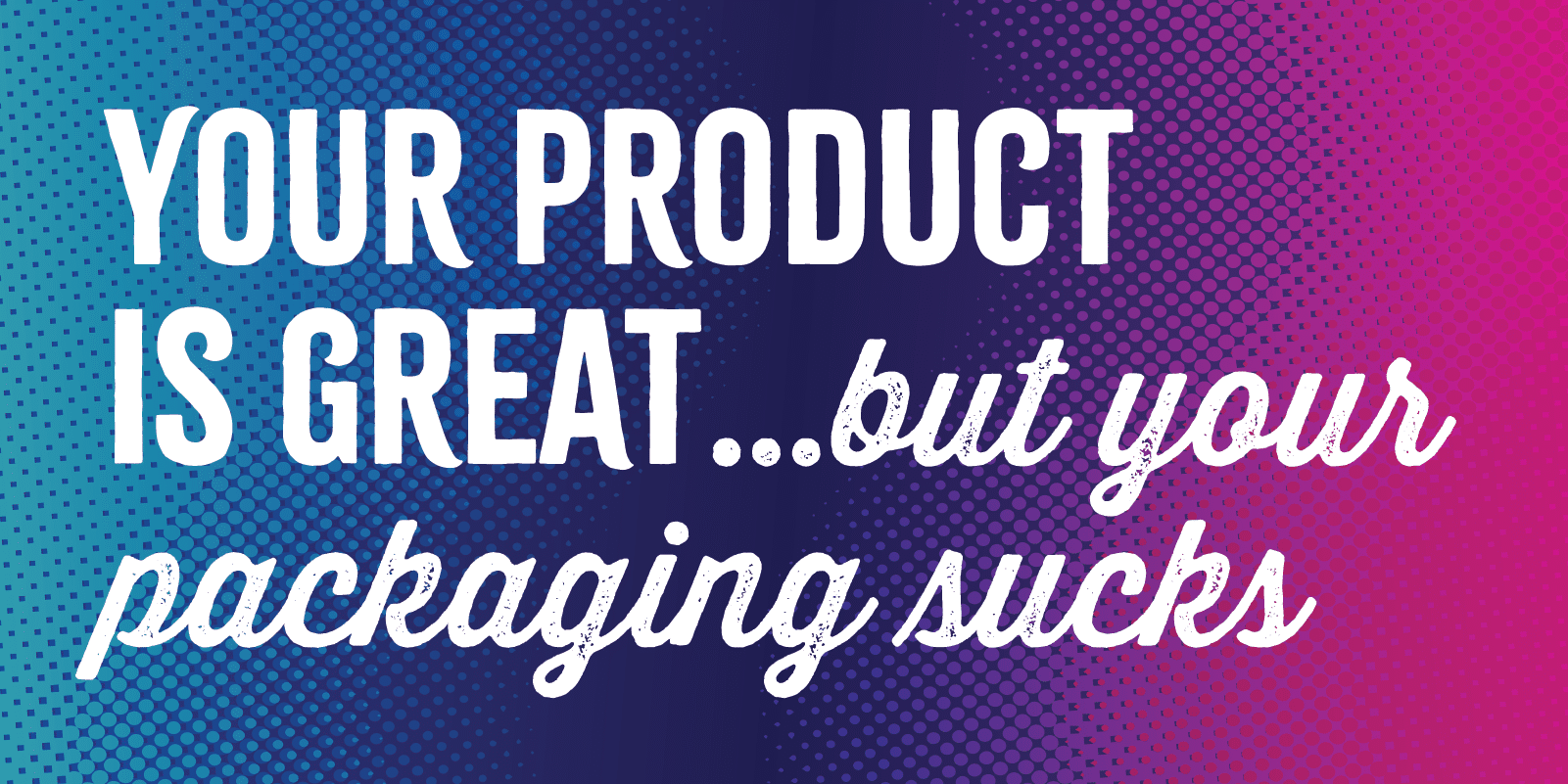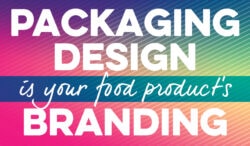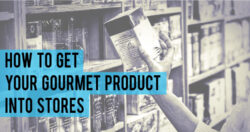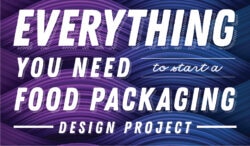How to Avoid Bad Packaging Design
“Your product is great but your packaging sucks.” How often do I hear this story recounted from brand owners? All. The. Time. Full story goes like this: Store buyer takes interest in a food brand’s products, loves them, wants to carry them in their stores, but tells the brand that they won’t at this time—because of their packaging design. They are told their food product packaging design or beverage packaging is amateur, unprofessional, ineffective—fill in the blank, it flat-out sucks. Yes, those exact words have been used. I’ve heard a variation of this story countless times from brands who approach us to engage in a partnership. What can you do to prevent having this be your brand story? And if you find yourself in this situation, what can you do about it?
The Often-Overlooked Role of Food Packaging Design — #1 Driver of Food Product Sales.
Why is food packaging design important? Strategic packaging design doesn’t just make your product look good and increase sales—it opens doors for your brand and food business. You want your product to be featured in the big-name stores—Costco, Walmart, Kroeger, Sprouts, Sam’s Club, Whole Foods, and the like. So when you get the opportunity to present to these stores, or if they discover your products online, as we are increasingly seeing—for example via KeHe, UNFI, or other distributors—you want to make your best-possible impression with premium packaging design, because those opportunities are golden. Your packaging design doesn’t just speak to the end consumer, it must also appeal to the gatekeeper to your audience, which is the store category buyer.
How Did I Get Here? Packaging Design Mistakes.
Ineffective food packaging design can result from a number of different factors:
- Misguided Food Packaging Design Budgeting. A brand puts so much work into product development (because really, if the product is not great, no amount of strategic, amazing packaging design will save you), and the packaging becomes an afterthought. Because of misguided budgeting, or lack of budgeting, the last hurdle to getting a product to market is left with no funding. Thus the brand does not end up with great packaging design, or even good package design. And, well, you really do get what you pay for here.
- Going Cheap. You can get “packaging design” for cheap via online crowdsourcing platforms, or perhaps you have a friend, neighbor, or relative who knows how to use Adobe programs. This approach will most likely result in poor packaging. Knowledge of design programs does not make a designer. Also, graphic designer does not equal food packaging design specialist.
- Bad Food Packaging Design is Commonplace. Because there are countless food products in the market, the general bar can be low with many bad packaging examples on the shelf. Too many brands settle for “good enough,” and their product packaging has some or many bad packaging characteristics. The brands that truly rise above the clutter and make it big know the value and importance of strategic food branding and good packaging design. They understand that budgeting appropriately for this is an investment in the success of their brand that, when done right, pays for itself quickly—and more often than not, pays back multifold.
What Do I Do if My Food Packaging Design is NOT Working?
Did you have that friend design your food packaging, or did you crowdsource it with many graphic designers for cheap? Perhaps you got your product into stores and it’s not selling well, or you’re finding your packaging is a barrier to entry into stores. Here’s what you can do:
Tip 1: It’s OK to Let Go. It’s likely that there is not much—if anything—to retain in your current design if you’re still just starting out, so don’t hesitate to scrap your current look entirely and start fresh. In fact, this is often a good idea. If you try to hold on to things that aren’t working, you might get incremental change but nothing drastic. Let’s face it, you will need drastic change if you determine that you currently have bad food packaging.
Tip 2: Do it Right This Time. You can’t afford the time, hassle, and cost of two failed branding and packaging attempts. Make sure you work with an expert who can guide you through the process, recommend best practices and approaches, and in turn makes the process easy for you—so you don’t have to figure everything out on your own.
Tip 3: Go Big or Go Home. If you’re not putting a full effort into your brand package or packaging development, or if you’re not allocating the funds needed to do it properly, it’s time to ask yourself if you’re really committed to your brand for the long haul. There are countless food products in retail, and to stand out you need to take some risk and be bold with your brand. That takes investment—time and money. In my experience, these bold moves always pay off when the people behind the brand are fully committed.
Even if this is your first go-around on your brand’s design development, the above tips are still applicable to keep in mind as you develop your food product branding and effective packaging design, or if you are about to embark on that process. These design tips also apply to any type of food product, no matter what type of packaging.
Prevention is the Best Policy.
So you’re ready to start on the visual development of your brand. You’ve put time, sweat, and money into developing your food product to get it to this point. You don’t want to find yourself down the road in the position described above, where you’ve gone through this process only to find that it was a waste of time and money, and you have to start all over again—or even worse, fold.
Why do you need an amazing packaging design? Food branding and packaging design is not just another expense to try to find as cheaply as possible.
Design is a strategic tool for visual communication that can make or break your brand. Strategic design is an investment. Invest in your own success.
“Design is a strategic tool for visual communication that can make or break your brand.”
—Jenn David Connolly
I’ll say it again because it can’t be overemphasized: Design is visual communication. It is not a pretty dressing on the final product, nor is it art. Design is born from information and guided by achieving specific goals. Design communicates, which is exactly what you want your product to do in retail. It communicates at a glance and with words—and all the individual elements and messaging must be cohesive to function effectively together as a whole.
If you don’t have much experience with food packaging design and branding, you may not realize how much effort, strategy, and planning goes into creating innovative packaging. Certainly, making the most of the 2–3 second window of opportunity your product has—when it first captures a consumer’s attention—is a main focus. From there, the packaging information must meet or exceed consumer’s expectations and motivate the consumer to buy a product. As mentioned, appealing to store buyers is a key focus as well. You also want to be wary of excessive packaging, and prevent any problems with packaging. The design must serve a number of functions, with the above all being good packaging design criteria, and it’s essential that each function is specifically planned for.
Time and time again I have seen brands that shudder at the thought of investing a proper amount in their design development, but it ends up costing them a lot more in lost sales and lost opportunities. Honestly, the difference between good and bad packaging design is night and day for the life of a food brand.
Don’t let your packaging and branding design be an afterthought.
—
Ready to invest in your food brand’s success? Get started here. If you want to know more about good vs bad packaging design, sign up for our book release updates here.





